The evolution of electric scooters – The path to electric micromobility
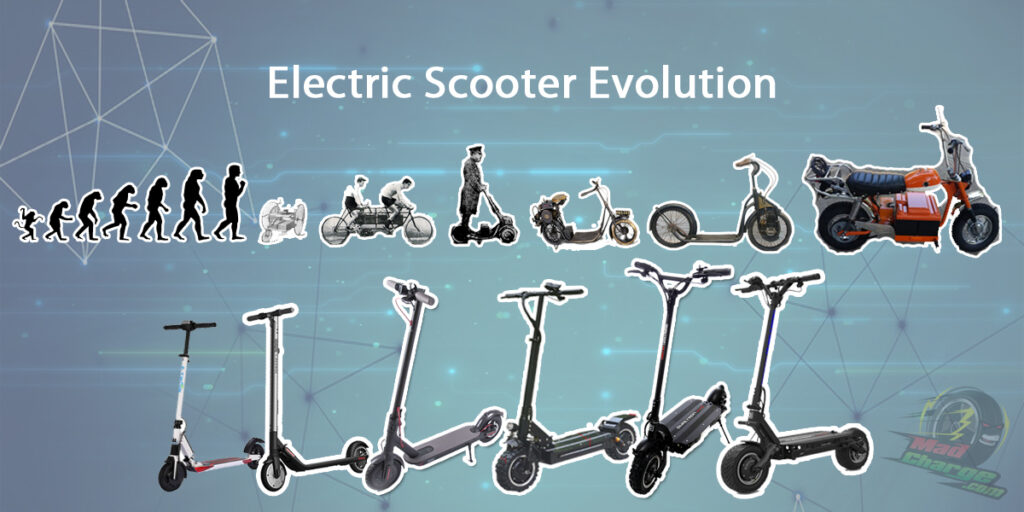
Electric scooters have only gained popularity in the last decade or so but it’s origin is quite a story to tell. The evolution of electric scooters is going to take you back to a time when scooters were just a plank of wood with some roller skates for wheels and a wooden handle. Back to the beginnings of mass entrepreneurship and development into the main stream. We are going to take you back to the time when the first motorised scooter was build to the development of the electric scooters if today.
The First Kick scooter
The kick scooter concept stretches back at least a century. In 1817 the Velocipede was first introduced by Baron Karl von Drais de of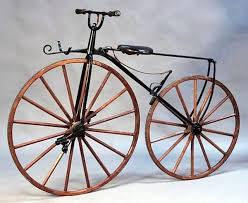 Germany. After he debuted his early two-wheeled, human-powered ride, the Velocipede concept was quickly spun off into bicycles, tricycles and kick scooters. The velocipede concept was more like a bicycle without a chain drive. The pedals were directly fitted on the front wheels.
Germany. After he debuted his early two-wheeled, human-powered ride, the Velocipede concept was quickly spun off into bicycles, tricycles and kick scooters. The velocipede concept was more like a bicycle without a chain drive. The pedals were directly fitted on the front wheels.
 The evolution of the kick scooters is an interesting tale of kids who had vivid imaginations and creative impulses to build and create kick scooters that were fully functional recreational vehicles. They were homemade by taking roller skates wheels and attaching them to small plank of wood. The handle was made of wood and was constructed by 2×4. The handle bars were made by splitting another 2×4 or were made from a piece of pipe that were positioned to the top of the handle bars for a handle. As bad as the design sounds it worked well and got children to places which made walking sound primitive. Riders can lean to turn, or by using a second board connected by a crude pivot. The construction was all wood, with 3–4 inch (75–100 mm) wheels with steel ball bearings . An alternative construction consists of one steel clamp on a roller skate divided into front and rear parts and attached to a wood beam.
The evolution of the kick scooters is an interesting tale of kids who had vivid imaginations and creative impulses to build and create kick scooters that were fully functional recreational vehicles. They were homemade by taking roller skates wheels and attaching them to small plank of wood. The handle was made of wood and was constructed by 2×4. The handle bars were made by splitting another 2×4 or were made from a piece of pipe that were positioned to the top of the handle bars for a handle. As bad as the design sounds it worked well and got children to places which made walking sound primitive. Riders can lean to turn, or by using a second board connected by a crude pivot. The construction was all wood, with 3–4 inch (75–100 mm) wheels with steel ball bearings . An alternative construction consists of one steel clamp on a roller skate divided into front and rear parts and attached to a wood beam.
Early model of the kick scooters inspired the generations of today. Kick scooters have been around for 100 years or so but were never as popular as the bicycle or some form of other recreational transport. This is why we have only seemed them massively produced in the last 50 years or so because the bicycle was more popular to commercialise.
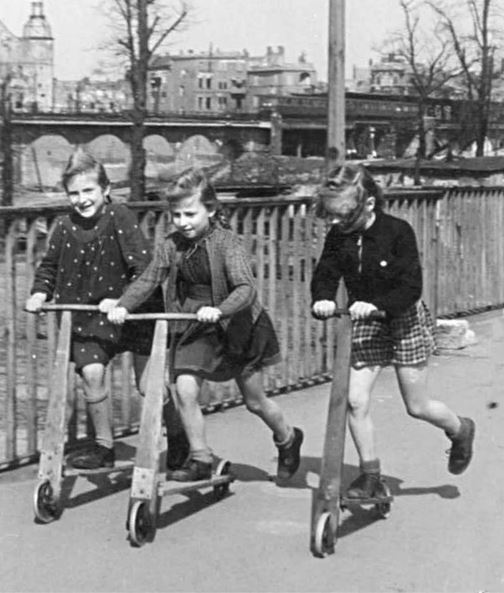
The first manufactured pulley kick scooter
The first massively produced scooter was not invented by a toy maker but was invented by Honda. Executives at Honda realised 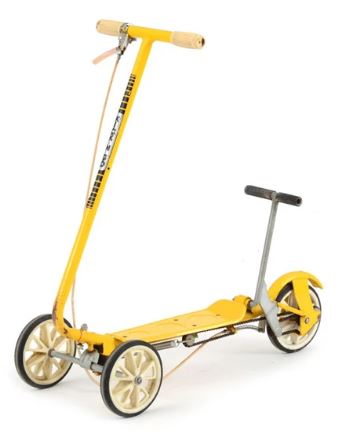 that there was little to entertain children while parents were at Honda car showrooms. Honda executives decided to hold an idea contest which was done internally at Honda. Akuto, a subsidiary of Honda helped the developed a kick scooter. It was called the Kick “N” Go scooter and it was sold in Japan by GOGO. After 2000 test units were sold in local Japanese Honda stores in 1974 via the official dealership Honda realised that the scooters were an instant hit and decided to market Japan and US. They were exclusively sold in the US dealerships and were successful until 1976.
that there was little to entertain children while parents were at Honda car showrooms. Honda executives decided to hold an idea contest which was done internally at Honda. Akuto, a subsidiary of Honda helped the developed a kick scooter. It was called the Kick “N” Go scooter and it was sold in Japan by GOGO. After 2000 test units were sold in local Japanese Honda stores in 1974 via the official dealership Honda realised that the scooters were an instant hit and decided to market Japan and US. They were exclusively sold in the US dealerships and were successful until 1976.
The design of the Kick “N” Go was very unique for its time period. The first models were a yellow metal construction. It had a unique design of 2 wheels in the front and 1 wheel in the rear. The steering was controlled by leaning to left to turn left and leaning to the right to turn right. This is just like a skateboard in terms of steering. The front wheels were mounted to an axle of a skateboard truck hinged in the middle and were installed with rubber so it can bend to tilt to the corner. It had a manual brake lever mounted on the handlebar just like a bicycle and this would brake the back wheels.
What set this system to all other systems was the scooter’s movement system. This was extremely unique for its time. It had a T-shaped lever at the rear that was connected to a chain belt pulley that connected to the rear wheel hub. It is a first of its kind. To operate you would kick the T-shaped metal lever backward to pull the chain connected to the pulley sprocket away from the other sprocket on the rear wheel. The rear wheel hub has a one way clutch, so when the foot is on the rod. It stands. When the return spring returns and chain springs back, the hub will separate from the device.
The rider pumps the T-lever up and down to get scooter in motion. This is why the scooter was named Kick “N” Go. It was the first kick scooter to have its own movement system and braking system.
There were 3 models made in total. The first model was made in 1974 and was the yellow Kick “N” Go. The second model was red and made in 1976 and was called the Kick “N” Go 2. This scooter was designed for older children in mind and the steering was designed like a bicycle instead of the original truck system. The 1976 Kick “N” Go Senior was a larger model than the original Kick “N” Go. It was marketing for older children and adults.
They were discontinued when 2 children were killed in an accident while riding them. The US safety committee decided that the scooters were too powerful for children to ride so they were discontinued in 1976. It is strange that they were pulled from the stores as they were not more dangerous than a skateboard, bicycle or the motorised scooters that were gaining popularity at the time.


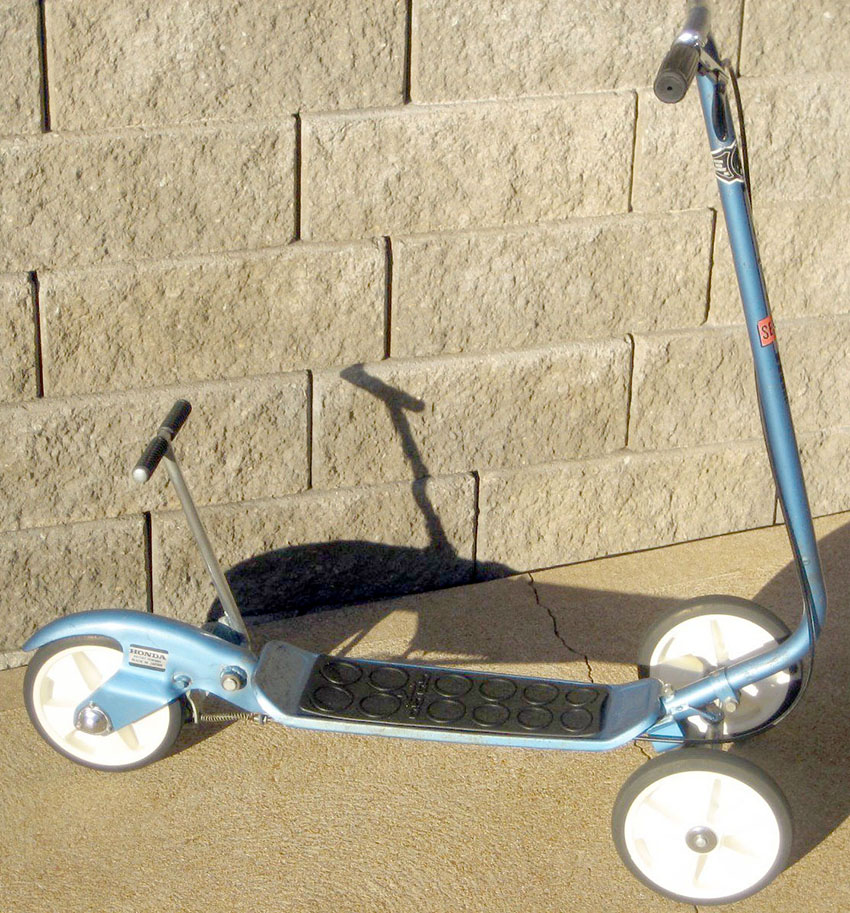
The Modern day kick scooter
What better way to discuss the evolution of electric scooters than to discuss the modern day kick scooter. It is an interesting story which spawned from laziness to eventually coming up with a commercially viable product.
This modern-day 2 wheel scooter was invented by a man named Swissman Wim Ouboter and he invented it due to laziness. Ouboter like all Germans had a love for sausages. His favourite shop was Zurich’s, Sternen Grill. He knew it was to far for him to walk, but close enough that he didn’t feel it warranted the trouble of riding a bike. Ouboter’s gastronomic dilemma would lead him to the creation to the most commercially viable kick scooters at the beginning of the 2000s.
Ouboter work on a prototype scooter and it didn’t appeal much to his friends but caught the eye of a automobile manufacturer called Smart, which tentatively agreed to stock the creation in each of it’s cars. Smart attention turned into struggles, and his sleeping giant was relegated to the attic.

Outboter kept tinkering with the scooters. He created 3 wheel versions of the ride – The Kickboard. He showcased The Kickboard to a American sporting goods company called K2 at the international Sports Fair in Munich in 1998. The success of the Kickboard launched Outboter’s Micro Mobility Systems in 1999 which manufactured his 2 wheeled concept design. Supply and demand was so high that Outober allowed a Taiwanese production partner to distribute the scooter to the United States. In the United States they commissioned the company Razor.
Razor became very popular and sold one million units in 2000. The brand continued to iterate the original concept, creating different colour wheels.
The Razor had 2 inline skate wheels and was a much smaller scooter to its predecessors. It was made out of metal and could be folded for portability.
The first motorised kick Scooter
In the early 20th century there was a group of people who wanted to change the transport industry for the betterment of society. These people were scientists, activists, businesses. There were also criminals who used the opportunity to conduct criminal activities. In this article I am going to explain all of this history.
What better way to discuss the evolution of electric scooters than to discuss the world’s first motorised scooter. We are talking about a time before the introduction of Lime or Voi which are part of the dockless scooter empire. It was a time before road legislation, traffic lights, and roundabouts. This period was a time where the dominant vehicle on the road was a horse and carriage. It was a time when the motorised scooter boom and was over 100 years ago. The scooter was used during the world war 1 effort.
Peter Minton was a 16 year old boy who was riding around on a scooter on a Rockway Beach Boulevard. A patrolman had pulled him over and asked for his drivers license. Minton was not zipping along on a Lime, Bird, Skip or Spin vehicle. Instead this story was in 1939 when motorised scooter was booming like a flower opening up during the spring time. The scooter industry was booming long before Silicon Valley companies were pivotal during the late 20th century.

As mention previously in my article Baron Karl Von Drais de Sauderbrun invented the first concept scooter called the velocipede. This led to the invention of the first scooters and bicycles. The first patented battery power vehicle was invented by Ogden Bolton Jr in 1895. The first motorised kick scooter was called the Autoped and it was the true ancestors to the modern-day scooters. It was invented at a time when the first statewide traffic law to regulate motor vehicles was put into practice in 1901 and New York drunk driving laws were written a decade later. When the Autoped was invented traffic lights were still 15 years away from being introduced.
The vehicle was invented by Arthur Hugo Cecil Gibson although he had the help of Joseph F. Merkel a designer of the time for the 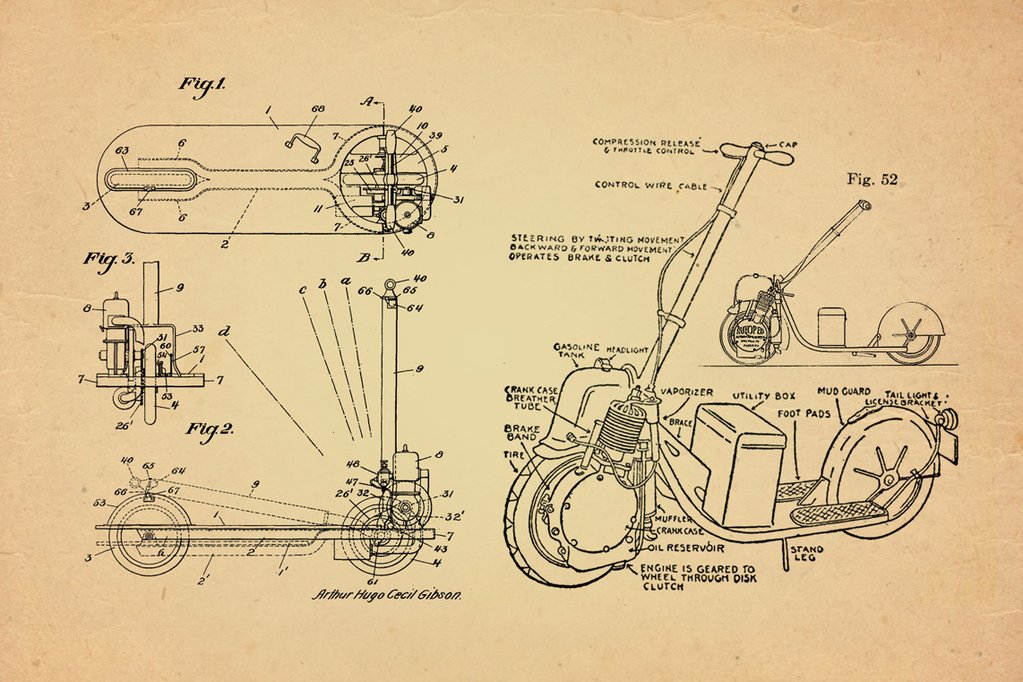 final product. The vehicle was dubbed the “self-propelled vehicle”. It was manufactured by a company called Autoped Company of America and was first incorporated in 1913. The shop was setup in Long Island in Queens, New York in the fall of 1915. The original patent for the Autoped was applied for in 1913 and granted in 1916 by the US Patent Office.
final product. The vehicle was dubbed the “self-propelled vehicle”. It was manufactured by a company called Autoped Company of America and was first incorporated in 1913. The shop was setup in Long Island in Queens, New York in the fall of 1915. The original patent for the Autoped was applied for in 1913 and granted in 1916 by the US Patent Office.
The Autoped was powered by an air-cooled four-stroke 155c single-cylinder engine with a single carburettor and had a small exhaust with small discreet muffler. It had 1.5hp of horsepower which was more than enough power for the rough roads of the time but the braking system was somewhat limited. It had a metal construction and you could stand on it while riding it.
There was a lever on the handlebars that would control the throttle you would push the handlebars forward to disengage the clutch and engage the brake. The rider would stand on a central platform. It had 10-inch tires and the motor is installed over the front wheel hub next to the fuel tank. Autoped was user-friendly and to insure the rider fell off the back the handlebars would automatically move back to disengage the clutch and engage the brake. It had a folding handlebar for easy storage.
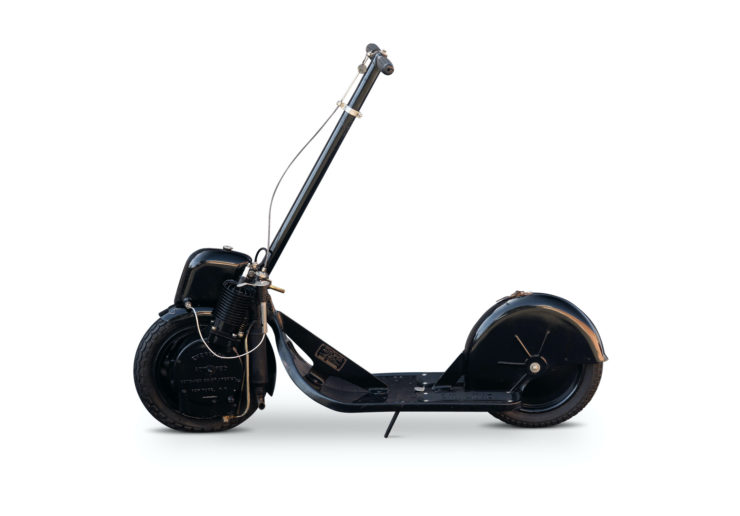
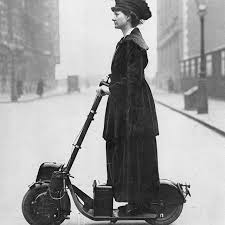
The Autoped was marketed as a short distance conveyance for business or professional men or women to and from their places of business. It was massively marketed for women as you can see in the picture. Priscilla, Lady Norman the English socialite was a suffragette and activist. She was given an Autoped by her husband for a birthday present Sir Henry Norman. She used to travel to her office in central London. She followed in her mothers footsteps in her active support for women’s suffrage. This gave women of this time massive independence as they could go about their day with liberation in hand. A vehicle to call their own. Below I have captured the marketing of the vehicle at the time with painting of a lady zipping through the streets like lightening!
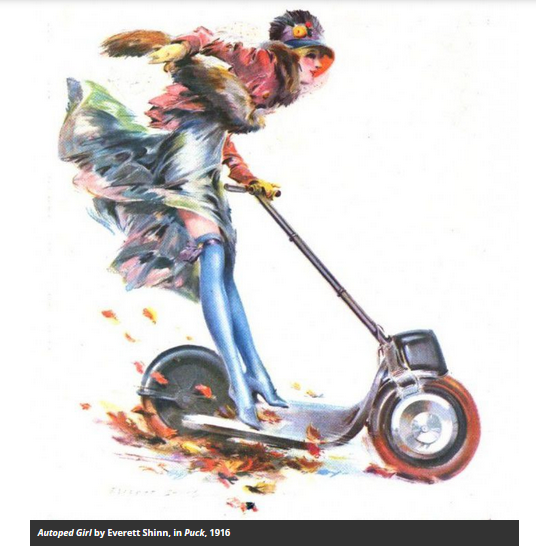
“The Autoped is an ideal short distance conveyance for business or professional men or women to and from their places of business; for women to go shopping or calling; for physicians to make their regular daily calls or to answer hurry calls; for the older children to go about quickly for outing or school; for servants when they are sent on errands; for grocers, druggists and other merchants for quick delivery purposes; for commercial salesman to call on the trade; for employees to ride to and from work; for collectors; repairmen; messengers, and for anybody else who wants to save money, time and energy in going about. All will enjoy the comfort and pleasure of AUTOPEDING.”
The U.S Postal service had tested these vehicles as means for fast transport for the special delivery service. I have pictured a group of postal workers with the Autoped in hand and gosh what a photo. These vehicles were probably the first fleet vehicles of their day. The foldable vehicles were also used as a quick getaway machine for New York street gangs. They were caught riding through narrow alleyways which were beyond the reach of police cars at the time.
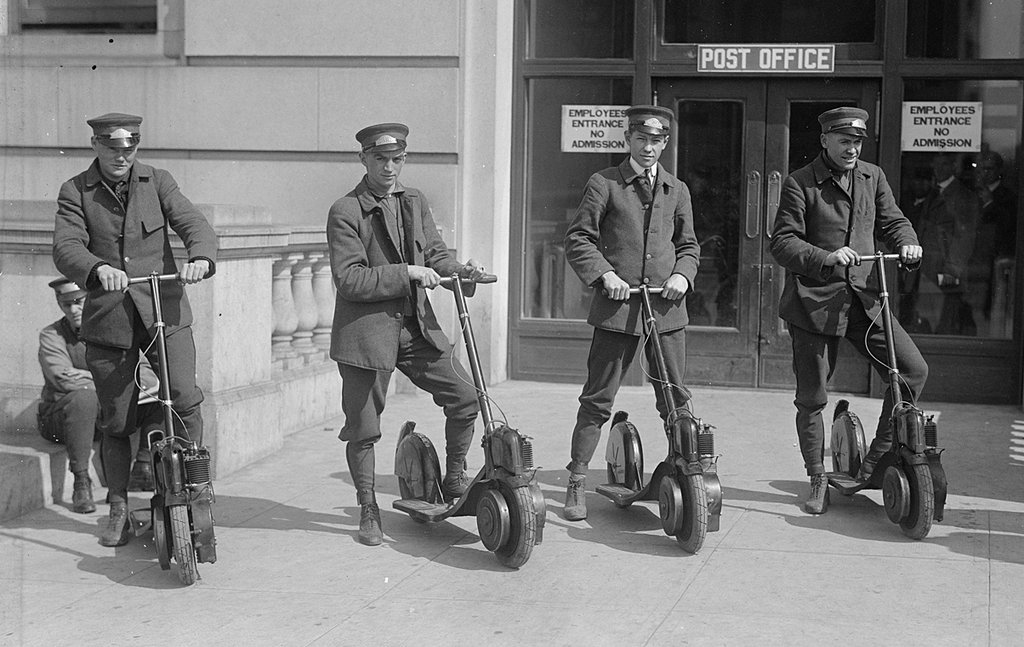
The Autoped was seemingly well publicised in it’s day, and contracts were gained with the U.S. Postal Service as a special delivery vehicle and police forces as a patrol vehicle. It clearly performed it’s tasks as advertised, as this was a significant public expenditure.
During the Great War it became clear that the Allies needed to spare as much gasoline as possible if they intended to win the war. This vehicle was important vehicle for the war effort as the vehicle did not use much gasoline as any other vehicle on the market. So it was marketed out to the general market and was used during the war effort for gasoline rationing.
After World War 1 ended in 1918 Autoped the company folded in 1921. This was because the vehicle did not gain as much popularity compared to the other vehicles that were out on the market at that time. However Krupp manufactured their own slightly more powerful licensed version of the Autoped from 1919 to 1922 In Germany.
Autoped was not the only scooter of it’s time. There was the ABC Skootamota, Unibus, Kenilworth, and the Lomos. All these scooters were not kick scooters as they had a seat on the back of the rear axile. The Autoped was a kick scooter and it was a very well built one for it’s time. Unfortunately the first generation of motor scooters were short lived as they were either expensive to buy. A lot of the first generation scooters went out of business by the mid 20’s and scooters weren’t thought of again really until the mid 30’s. The Autoped was a stable vehicle to the micro mobility market of the day. I do not think we would be where we are today without the significance of these vehicles.
The 2nd Generation of motorcycle scooters
It was the time of the Second World War and people were struggling due to the financial crash of the early 30’s. It was time for a  new generation of motor scooters. One that was built strong and commercially viable. E. Foster Salsbury and Austin Elmore developed the Salsbury Motor Glide. The seat was above the enclosed drivetrain and began construction in 1936 in California.
new generation of motor scooters. One that was built strong and commercially viable. E. Foster Salsbury and Austin Elmore developed the Salsbury Motor Glide. The seat was above the enclosed drivetrain and began construction in 1936 in California.
The Cashman Auto Glide was born out of pure rivalry by Salsbury. The vehicle claimed to have an efficiency of 120 miles per gallon at 30 mph. Their was a massive adervertising campaign in relation to this at the time which we have show cased in this aricle.
Cushman scooters were widely used by the United States Armed Forces in World War II. It was an alternative to automobiles before and after World War II. The Cushman Auto Glide Model 53 was designed to be dropped out of a parachute with Airborne troops inside. Cushman scooters were used in military bases for the messenger service.
The moden day combustion engine kick scooter
The new motorised combustion engine kick scooters did not come back in until the 1980’s. That is 65 years after the Autoped was invented in the early 20th century. In 1985 a young man by the name of Steve Patmont and his wife Hannelore plus his 2 sons Gabe and Tim launched a company called Patmont Motor Werks. They produced a prototype for a new motorised personal transport device. This was the start of the famous Go-Ped.
The market in those days had endless opportunities for a family who wanted to live the American dream and to manufacture a product of this type in the United States. The Patmont family had secured a patent and began shopping their invention around to purveyors of yachts and personal aircrafts as a light, portable alternative transport device. They wanted to extend their transport choices for practical utility and recreational uses.
The Go-Ped Sport scooter was invented in 1985. It was a spindle-driven, hard tire scooter that ran on a Zenoah G2D-58 29cc two-stroke engine that required oil mixed in with the gasoline. It had a top speed of 20mph and a range of 10miles with the stock gas tank. The tank could be upgraded to a 1-liter gas tank which would give 15 miles of range. It was foldable for portability. It had a spindle direct drive transmission that improves the power delivery to the rear wheel which helps keep moving parts, size, and weight of the Sport to a minimum. The front wheels had caliper brakes and the rear was engine compression.
The deck was made out of wood and the frame was made out of Chromyl. It weighed 20lbs. The Sport was only limited to on-road conditions and did not give you a good ride if you were on the dirt. The throttle was on the right-hand side and it was a two-finger trigger.
This scooter was a massive success and the company still exists to this day. Today Patmont Motor Werks remains family-owned with a dedicated extended family working as employees, vendors, authorised dealers, and loyal customers. Who would have thought a family business that started off in the garage would turn out to be a tremendous success. Talk about living the American dream.
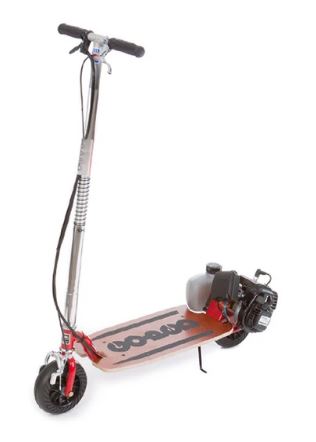
The first electric scooter
Over the years Geo-ped became one of the biggest motorised scooter companies on the market. They had refined and improved its designs for their ergonomics, form, function, and handling through testing, racing, and pushing their machines to the limits but still, there was something missing from this. The company wanted to develop one of the first electric kick scooters that was just as powerful as the Sport models. They introduced the ESR 750 electric scooter range in 2003, as a green alternative for those who want to reduce their carbon footprint, but still want a motorised transportation experience.
Go-ped ESR750 Hoverboard is a chain-driven, air tire scooter. This was one of the most successful scooters that Go-Ped had produced. It was developed in 2004 and it had a 24v-750W Brush D/C motor with a 12volt battery. It had a range of 10 miles and a top speed of 20mph. The transmission was still a chain drive system. It had a front disc brake system for the front wheels and engine braking for the rear. This means when the throttle was released the engine would slow the vehicle down. The deck was made from wood and the frame was made from Chromyl. This was exactly like the Sport models.
The price of the scooter is $1000. That is a hefty price tag compared to today’s standards. The high price really does provide a number of technological innovations and unique capabilities to Go-Ped scooters. The most important ones are the auto-adjusting chain tensioner, dual performance modes (Econo or Turbo mode, to go “twice as far half as fast” or “twice as fast half as far”), on-board charger, and tweakable electronic controller. The motor is capable of producing more than 1 BHP of power, which results in excellent acceleration and top speed.
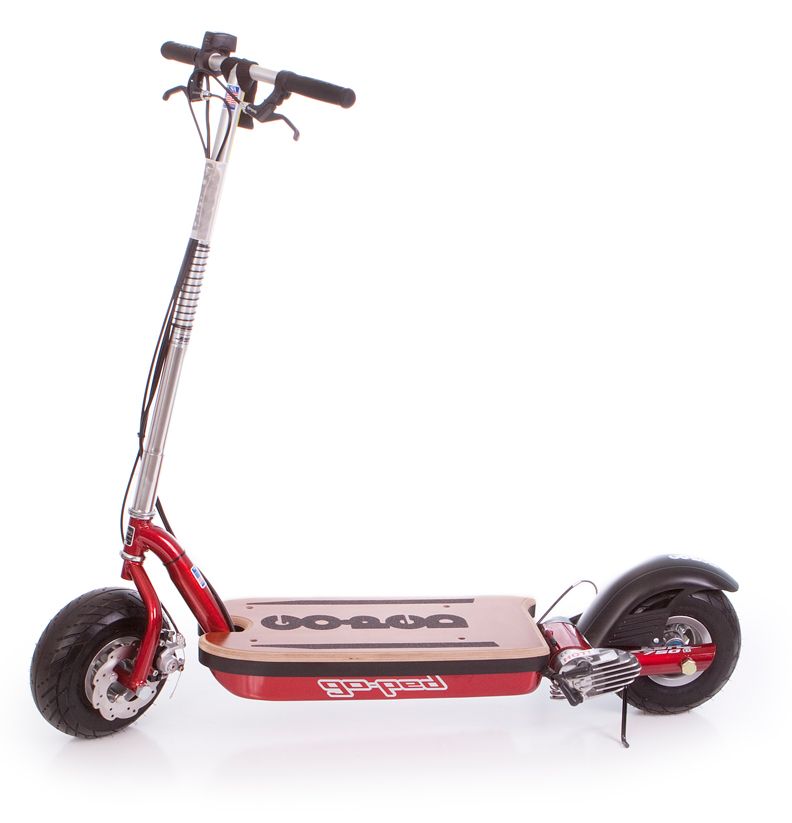
Go-Ped ESR750 Hoverboard
Conclusion
Who would have thought that the electric kick scooter would be such a dominant vehicle to have in the 21st century. If only the inventors of Autoped could see the success of electric kick scooters today. I think they would be blown away. You have many electric scooter companies out there and they do not cost a lot of money either. You can pick an electric scooter these days for less than £300. This is due to the market growing and vehicle becoming popular with in the micro mobility community.

Click on the links above to see the current up to date electric scooters on the market.






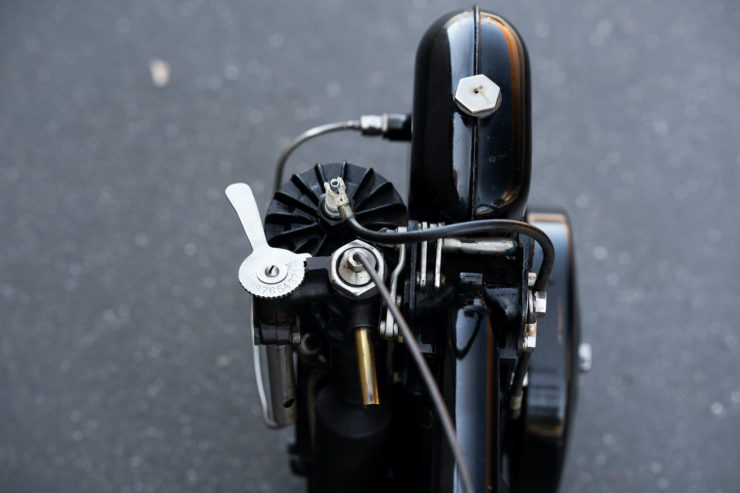
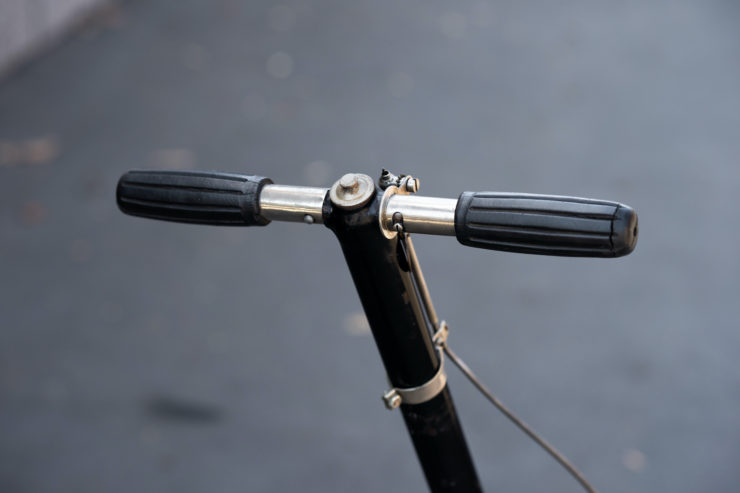
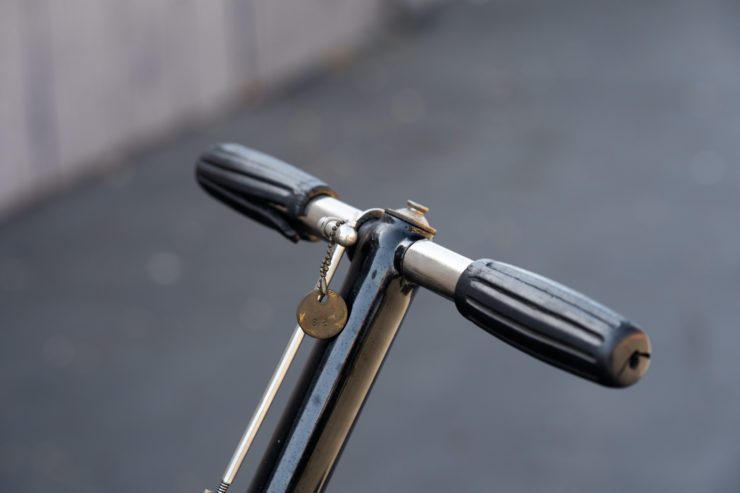

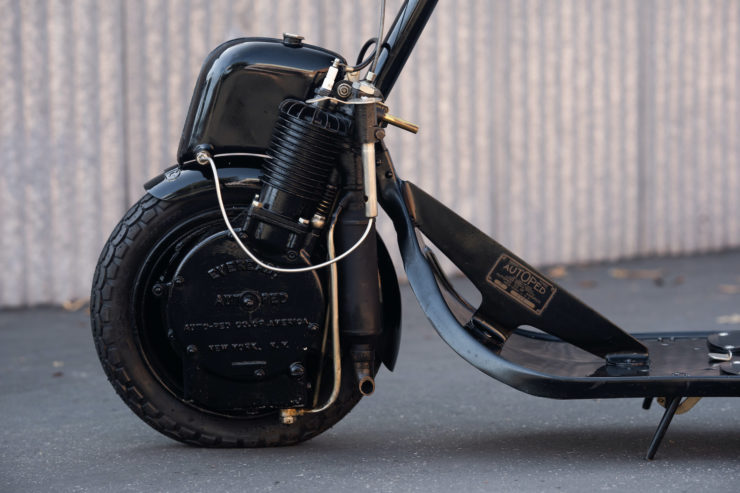


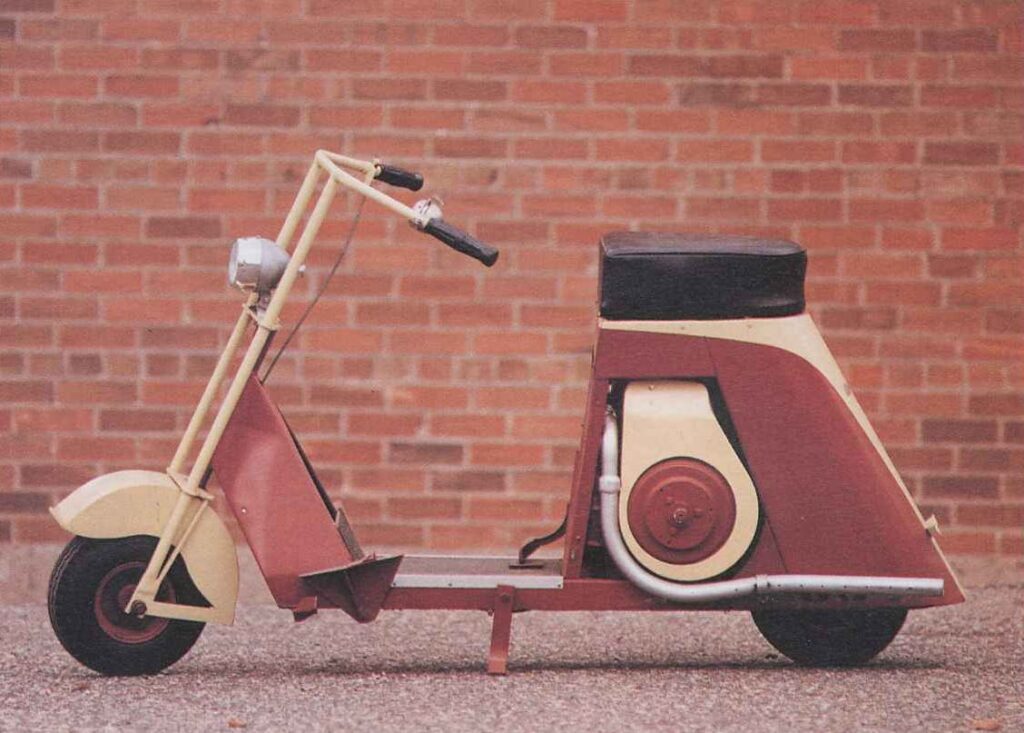



Recent Comments